Green wall
_(7166632353).jpg)
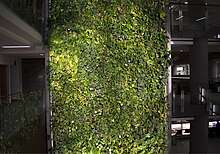
A green wall is a wall partially or completely covered with greenery that includes a growing medium, such as soil or a substrate. Most green walls also feature an integrated water delivery system. A green wall is also known as a living wall or vertical garden. It provides insulation to keep the building's inside temperature consistent.
It is useful to distinguish green walls from green facades. Green walls have growing media supported on the face of the wall (as described below), while green facades have soil only at the base of the wall (in a container or in ground) and support climbing plants on the face of the wall to create the green, or vegetated, facade.
Green walls may be indoors or outside, freestanding or attached to an existing wall, and come in a great variety of sizes.
Stanley Hart White, a Professor of Landscape Architecture at the University of Illinois patented a "vegetation-Bearing Architectonic Structure and System" in 1938, though his invention did not progress beyond prototypes in his backyard in Urbana, Illinois.[1]
Patrick Blanc, a botanist specialized in tropical forest undergrowth, worked with architect Adrien Fainsilber and engineer Peter Rice implementing the first successful large indoors green wall in 1986 at the Cité des Sciences et de l'Industrie in Paris. In 2005, he created the landmark vegetal exterior wall of the administrative building of the Musée du quai Branly with architect Jean Nouvel.[2][3]
Green walls subsequently saw a rapid surge in popularity. Of the 61 large-scale outdoor green walls listed in an online database provided by greenroof.com, 80% were constructed in or after 2009 and 93% in or after 2007.[4] Many iconic green walls have been constructed by institutions and in public places such as airports and are now becoming common.[5]
As of 2015, the largest green wall covers 2,700 square meters (29,063 square feet or more than half an acre) and is located at the Los Cabos International Convention Center, a building designed by Mexican architect Fernando Romero for the 2012 G-20 Los Cabos summit.[6]
Media types
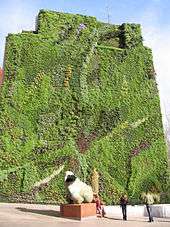
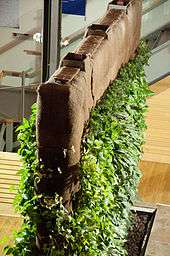
Green walls are often constructed of modular panels that hold a growing medium and can be categorized according to the type of growth media used: loose media, mat media, and structural media.
Loose media
Loose medium walls tend to be "soil-on-a-shelf" or "soil-in-a-bag" type systems. Loose medium systems have their soil packed into a shelf or bag and are then installed onto the wall. These systems require their media to be replaced at least once a year on exteriors and approximately every two years on interiors. Loose soil systems are not well suited for areas with any seismic activity. Most importantly, because these systems can easily have their medium blown away by wind-driven rain or heavy winds, these should not be used in applications over 8 feet high. There are some systems in Asia that have solved the loose media erosion problem by use of shielding systems to hold the media within the green wall system even when soil liquefaction occurs under seismic load. In these systems, the plants can still up-root themselves in the liquified soil under seismic load, and therefore it is required that the plants be secured to the system to prevent them from falling from the wall. Loose-soil systems without physical media erosion systems are best suited for the home gardener where occasional replanting is desired from season to season or year to year. Loose-soil systems with physical media erosion systems are well suited for all green wall applications.
Mat media
Mat type systems tend to be either coir fiber or felt mats. Mat media are quite thin, even in multiple layers, and as such cannot support vibrant root systems of mature plants for more than three to five years before the roots overtake the mat and water is not able to adequately wick through the mats. The method of reparation of these systems is to replace large sections of the system at a time by cutting the mat out of the wall and replacing it with new mat. This process compromises the root structures of the neighboring plants on the wall and often kills many surrounding plants in the reparation process. These systems are best used on the interior of a building and are a good choice in areas with low seismic activity and small plants that will not grow to a weight that could rip the mat apart under their own weight over time. It is important to note that mat systems are particularly water inefficient and often require constant irrigation due to the thin nature of the medium and its inability to hold water and provide a buffer for the plant roots. This inefficiency often requires that these systems have a water re-circulation system put into place at an additional cost. Mat media are better suited for small installations no more than eight feet in height where repairs are easily completed.
Sheet media
Semi-open cell polyurethane sheet media utilising an egg crate pattern has successfully been used in recent years for both outdoor roof gardens and vertical walls. The water holding capacity of these engineered polyurethanes vastly exceeds that of coir and felt based systems. Polyurethanes do not biodegrade, and hence stay viable as an active substrate for 20+ years. Vertical wall systems utilising polyurethane sheeting typically employ a sandwich construction where a water proof membrane is applied to the back, the polyurethane sheeting (typically two sheets with irrigation lines in between) is laid and then a mesh or anchor braces/bars secure the assembly to the wall. Pockets are cut into the face of the first urethane sheet into which plants are inserted. Soil is typically removed from the roots of any plants prior to insertion into the urethane mattress substrate. A flaked or chopped noodle version of the same polyurethane material can also be added to existing structural media mixes to boost water retention.
Structural media
.jpg)
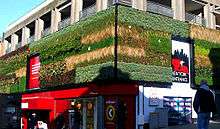
Structural media are growth medium "blocks" that are not loose, nor mats, but which incorporate the best features of both into a block that can be manufactured into various sizes, shapes and thicknesses. These media have the advantage that they do not break down for 10 to 15 years, can be made to have a higher or lower water holding capacity depending on the plant selection for the wall, can have their pH and EC's customized to suit the plants, and are easily handled for maintenance and replacement.
There is also some discussion involving "active" living walls. An active living wall actively pulls or forces air through the plants le quality to the point that the installation of other air quality filtration systems can be removed to provide a cost-savings. Therefore, the added cost of design, planning and implementation of an active living wall is still in question. With further research and UL standards to support the air quality data from the living wall, building code may one day allow for our buildings to have their air filtered by plants.[7]
The area of air quality and plants is continuing to be researched. Early studies in this area include NASA studies performed in the 1970s and 1980s by B. C. Wolverton.[8] There was also a study performed at the University of Guelph by Alan Darlington.[9] Other research has shown the effect the plants have on the health of office workers.[10]
Function
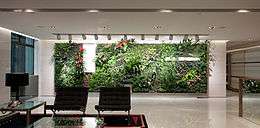
Green walls are found most often in urban environments where the plants reduce overall temperatures of the building. "The primary cause of heat build-up in cities is insolation, the absorption of solar radiation by roads and buildings in the city and the storage of this heat in the building material and its subsequent re-radiation. Plant surfaces however, as a result of transpiration, do not rise more than 4–5 °C above the ambient and are sometimes cooler."[11]
Living walls may also be a means for water reuse. The plants may purify slightly polluted water (such as greywater) by absorbing the dissolved nutrients. Bacteria mineralize the organic components to make them available to the plants. A study is underway at the Bertschi School in Seattle, Washington, using a GSky Pro Wall system, however, no publicly available data on this is available at this time.
Living walls are particularly suitable for cities, as they allow good use of available vertical surface areas. They are also suitable in arid areas, as the circulating water on a vertical wall is less likely to evaporate than in horizontal gardens.
The living wall could also function for urban agriculture, urban gardening, or for its beauty as art. It is sometimes built indoors to help alleviate sick building syndrome.
Living walls are also acknowledged for remediation of poor air quality, both to internal and external areas.
Sources
- Thomas A. M. Pugh; A. Robert MacKenzie; J. Duncan Whyatt; C. Nicholas Hewitt (2012). "The effectiveness of green infrastructure for improvement of air quality in urban street canyons". Environmental Science & Technology. 46 (14): 7692–7699. doi:10.1021/es300826w.
See also
- Building-integrated agriculture
- Folkewall
- Green roof
- The Hanging Gardens of Babylon
- Hügelkultur
- Musée du Quai Branly
- The Green Wall, a film
- The Green Wall: The Story Of A Brave Prison Guard's Fight Against Corruption Inside The United States' Largest Prison System, a book D. J. Vodicka about corruption in the California prison system
- Vertical farming
- Green wall in Joytown_Primary_School for physically challenged children, Kenya
References
- ↑ Hindle, Richard L. "Reconstructing the 'Vegetation-Bearing Architectonic Structure and System (1938)'". Graham Foundation. Retrieved February 20, 2013.
- Richard L. Hindle (2012): A vertical garden: origins of the Vegetation-Bearing Architectonic Structure and System (1938), Studies in the History of Gardens & Designed Landscapes: An International Quarterly, 32:2, 99–110
- ↑ "Vertical gardens a green solution for urban setting". The Times of India. Bennett, Coleman & Co., Ltd. Feb 14, 2013. Retrieved February 20, 2013.
- ↑ "Welcome to Vertical Garden Patrick Blanc – Vertical Garden Patrick Blanc". www.verticalgardenpatrickblanc.com.
- ↑ "The International Greenroof & Greenwall Projects Database!". greenroofs.com. Greenroofs.com, LLC. Retrieved 17 October 2013.
select 'green wall' as type and 'living wall' under 'greenroof type'
- ↑ "Upwards trend". www.airport-world.com. Airport World. Retrieved 29 March 2013.
An increasing number of airports are investing in vertical gardens and living walls to create a unique setting
- ↑ For largest wall as of 2012, see Eric Martin; Nacha Cattan (Jun 20, 2012). "Calderon Fetes G-20 as Sun Sets on Mexico Ruling Party". bloomberg.com. Bloomberg LP. Retrieved 17 October 2013.
- For size of wall, see "Los Cabos International Convention Center (ICC)". greenroofs.com. Greenroofs.com, LLC. Retrieved 17 October 2013.
- ↑ "Purdue Solar Decathlon". www.purdue.edu. Retrieved 2017-06-26.
- ↑ "Wolverton Environmental Services". www.wolvertonenvironmental.com.
- ↑ Indoor Air |Darlington, A.; Chan, M.; Malloch, D.; Dixon, M. A. Indoor Air 2000, 10, 39-46
- ↑ "The Effect of Indoor Foliage Plants on Health and Discomfort Symptoms among Office Workers". Retrieved 2010-12-23.
- ↑ Ong, B. (2003). Green plot ratio: an ecological measure for architecture and urban planning. Landscape and Urban Planning, 63 (4). Retrieved June 19, 2009, from ScienceDirect database.
External links
| Wikimedia Commons has media related to Green walls. |
